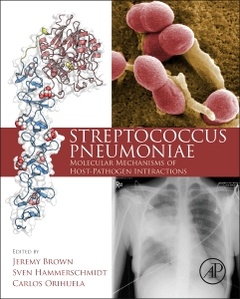Streptococcus Pneumoniae Molecular Mechanisms of Host-Pathogen Interactions
Coordonnateurs : Brown Jeremy, Hammerschmidt Sven, Orihuela Carlos

Streptococcus Pneumoniae: Molecular Mechanisms of Host-Pathogen Interactions provides a comprehensive overview of our existing knowledge on Streptococcus pneumoniae antibiotic resistance, dissemination, and pathogenesis, including immunology.
It presents a state-of-the-art overview of the implications of existing data, along with the areas of research that are important for future insights into the molecular mechanisms of pneumococcal infections and how to combat these infections.
Users will find a timely update on the topic, as the dramatic increase in antibiotic resistance pneumoniae cases and limitations of the currently available pneumoniae vaccines are creating new concerns on these gram-positive bacteria that are endowed with a high virulence potential, and are the most common etiologic agent of respiratory and life-threatening invasive diseases.
Section A: Streptococcus pneumoniae Epidemiology and Vaccines 1. Pneumococcal molecular epidemiology 2. Antibiotic resistance of pneuomocci 3. Pneumococcal vaccination and consequences 4. Protein based vaccines
Section B: Genetics and Functional Genomics of Streptococcus pneumoniae 5. Genomics, genetic variation and regions of differences 6. Functional Genomics of pneumococci (Transcriptional regulation) 7. Pneumococcal genetic recombination during colonization and biofilm formation 8. The pneumococcal cell wall 9. Capsule structure, synthesis and regulation 10. Pneumococcal ABC transporters and their role in physiology and multidrug resistance
Section C: Streptococcus pneumoniae Biology 11. Structure and functions of surface protein/choline binding proteins 12. Pneumococcal non-adhesive surface proteins 13. Biofilm formation under in vitro conditions 14. Pneumolysin
Section D: Pneumococcal Interactions with the Host 15. Nasopharyngeal colonization 16. Otitis media and biofilms 17. Pneumococcal pili and adhesins 18. Exploitation of host signal transduction pathways induced by S. pneuomoniae 19. Mechanisms of predisposition to pneumonia: infants, the elderly, and viral infections 20. Mechanisms causing the inflammatory response to Streptococcus pneumoniae 21. Immune evasion mechanisms of pneumococci 22. Cell mediated adaptive immunity to pneumococci 23. Pneumococcal invasion
students, scientists and practitioners in micro and molecular biology, cell biology and immunology, any scientist working with or again Streptococcus pneumoniae, clinicians such as medical doctors on pulmonary diseases, infection biologists, public health scientists.
Sven Hammerschmidt is Professor and Head of the Department of Genetics of Microorganisms at the University of Greifswald in Germany. He is a microbiologist and molecular biologist, graduated 1996 from Medical Microbiology at the Medical School Hannover and University of Hannover in Germany followed by a postdoc time from 1996 to 2003 at the Helmholtz-Centre for Infection Research, Braunschweig, Germany. This time was associated with two short-term stays as a visiting scientist at the Menzies School of Health Research, Darwin, Northern Territory, Australia. In 2003 he was appointed as head of a young investigator group at the Center for Infection Research, University of Würzburg, Germany and In 2007 Sven Hammerschmidt was appointed as an associate professor for Cellular Microbiology at the Max von Pettenkofer-Institute for Hygiene and Medical Microbiology, University of Munich, Germany. In 2008 he moved to the University of Greifswald and became full-professor for General and Molecular Genetics. In 1998 he received the Robert Koch prize for post-docs and in 2008 the Becton Dickenson Research Award of the German Society of Hygiene and Microbiology (DGHM). His research interests are focused on deciphe
- Provides an updated overview of our existing knowledge on Streptococcus pneumoniae antibiotic resistance, dissemination, and pathogenesis, including immunology
- Helps strengthen interdisciplinary networking and the focus of scientific resources by targeting epidemiology, vaccines, genetics, antibiotic resistance, clonal dissemination, Streptococcus pneumoniae biology, functional genomics, inflammasome, biomarkers, and more
- Multi-authored by leaders in the field who present a state-of-the-art overview of what the implications are of existing data, and the areas of research that are important for future insights into the molecular mechanisms of pneumococcal infections
- Supports combinatory networking in order to find new solutions in clinical therapies
- Reflects the most topical pneumococcal research trends
Date de parution : 05-2015
Ouvrage de 470 p.
19x23.3 cm
Thème de Streptococcus Pneumoniae :
Mots-clés :
3D structure; ABC transporters; Adherence; Adhesion; Aging; Animal models; Antibiotics; Apoptosis; Bacteriophages; Biofilm; Biosynthesis; Capsular switching; Capsule; Carriage; Cations; Cell division; Cell wall; Choline; Choline-binding proteins; Colonization; Compartmentalization; Competence; Complement; Concept of clone; Conjugate vaccines; Core genome; Cytolysin; Diagnosis; Drug resistance; Evolution; Extracellular matrix; Fluoroquinolones; Fratricide; Genetic exchange; Genetics; HIV; Haemophilus influenzae; Herd immunity; Homologous recombination; Identification from culture; Immune evasion; Immunization; Immunodeficiency; Indirect effects; Inflammasome; Inflammation; Influenza; Innate invasion; Integrin; Interleukin 17; Invasive pneumococcal disease; Lipoproteins; Lipoteichoic acid; Lung; MALDI-TOF; MSCRAMMs; Macrolides; Macrophage; Meningitis; Molecular typing; Moraxella catarrhalis; Mucosal immunity; Multilocus sequence typing; Murein hydrolases; Nasopharynx; Neuronal damage; Neutrophils; Non-adhesive; Optochin; Otitis media; Pan-genome; Pathogenesis; Penicillin-binding protein; Peptidoglycan; Phagocytosis; Pili; Pneumococcal disease; Pneumococci; Pneumococcus; Pneumolysin; Pneumonia; Pore formation; Protein vaccines; Pulsed-field gel electrophoresis; Quorum sensing; Quorum signaling; Regulation; Replacement; Resistance; S pneumoniae; Sepsis; Serotype; Serotyping; Serum proteins; Sessile cells; Signal transduction; Streptococcus mitis; Streptococcus oralis; Streptococcus pneumoniae; Streptococcus pneumoniae colonization



